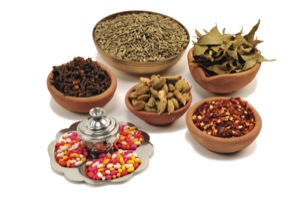
India is one of the largest and most populous countries in the world. Not surprisingly, it boasts an immense diversity of cuisines. India is larger than the whole of Europe, excluding Russia, and consists of 17 different states; five major faiths; and 15 major languages. An astonishing 1,500 dialects exist throughout the continent. For epicurious sojourners, a trans-Indian voyage is less a trip across the highways, byways and waterways of the world’s largest democracy than an adventure across India’s “foodways.”
India is a nation where foods differ from each of its 17 states as much as the foods from various countries in Europe. Geography is the main cause of India’s vast sublimity of dining differences. India has a wide range of climates – from the snowy Himalayas to the coconut palms of the tropical south – and the indigenous foods vary because of the weather.
Ancient history plays a huge part in all this too. Like those of the Middle East and China, India’s divergent civilizations’ traditions extend far back in time. Each civilization created its own cuisine and each led the next into a food revolution. Influences from neighboring areas also played a large part in Indian cuisine and its culinary immigration.
Moghul cuisine is probably the most important of all the cuisines in India, especially in the north. Moghul is the Indian version of Mongol. The Mongol empire was by far the greatest force in Asia in the middle ages. One enormous part of this empire included Afghanistan, much of Persia and the northern end of the Indian subcontinent. The highly refined and beautiful Persian dishes drew culinary inspiration into India and the cuisine was further developed and embellished.
Important categories of dishes which have Moghul origin include pilafs, kebabs, tandoor dishes and samosas. Rich dishes with almonds and pistachios are likely to be of Moghul descent as are sweet dishes flavored with saffron.
There is also the Portuguese influence to be taken into account as an important part of the development of Indian food. Goa, now part of India, was a Portuguese possession for 450 years. During this period its culture was an interesting mixture of Latin influences with its Muslim religion. The importance of the east-west trade conducted through Goa was reflected in the Goan food ways. This created an interesting blend of Portuguese and Indian cookery. The best example of this is probably Vindaloo, which was originally a pork stew imported from Portugal but “Indianized” by the addition of various spices.
Although there are various versions of cuisines throughout the country, there are some common factors. The main component of the meal is cereal (grains such as rice and oats), with savory dishes added as accompaniments and to provide flavor. Lentils and vegetables are also important. Spices – especially ginger and garlic – are used everywhere. The use of dairy products such as yogurt and ghee is also a prominent feature throughout the continent.
In Indian curries, as opposed to curries from South East Asia, the typical mixture is a blend of roasted and ground spices. Although, not set in stone, most you will find consist of coriander (which is the seed that grows cilantro), cumin, mustard seed, black pepper, fenugreek and turmeric. Some will add additions of cinnamon, cloves and cardamom.
When branching out and trying different cuisines from around the world, do so with an open mind. There will be some things you don’t like and others that you will crave, and remember, as with Asian restaurants, no two Indian restaurants will be the same.










